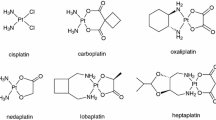Summary
The relationship between different chemical modifications on morpholinylanthracyclines and their ability to overcome multidrug resistance (MDR) has been evaluated testing all compounds in vitro on LoVo and LoVo/DX human colon adenocarcinoma cells and in vivo on disseminated P388 and P388/DX murine leukemias.
Results obtained led us to the following conclusions: 1) the insertion of the morpholinyl or the methoxymorpholinyl group on position 3′ of the sugar moiety confers the ability to overcome MDR in vitro and in vivo; conversely, 4′ morpholinyl compounds are effective on MDR cells only in vitro and result inactive in vivo on DX-resistant leukemia; 2) all chemical modifications performed on 3′ morpholinyl or methoxymorpholinyl derivatives, that is substitutions on the aglycone or on position 2 of the morpholino ring, do not interfere with the activity of the compounds: all derivatives present in fact the same efficacy on sensitive and resistant models.
It is concluded that position 3′ in the sugar moiety plays a crucial role in the ability of morpholinylanthracyclines to overcome MDR.
Similar content being viewed by others
References
Streeter DG, Taylor DL, Acton EM, Peters JH: Comparative cytotoxicities of various morpholinyl anthracyclines. Cancer Chemother Pharmacol 14:160–164, 1985
Streeter DG, Johl JS, Gordon GR, Peters JH: Uptake and retention of morpholinyl anthracyclines by adriamycin-sensitive and -resistant P388 cells. Cancer Chemother Pharmacol 16:247–252, 1986
Watanabe M, Komeshima N, Nakajima S, Tsuruo T: MX2, a morpholino anthracycline, as a new antitumor agent against drug-sensitive and multidrug-resistant human and murine tumor cells. Cancer Res 48:6653–6657, 1988
Watanabe M, Komeshima N, Naito M, Isoe T, Otake N, Tsuruo T: Cellular pharmacology of MX2, a new morpholino anthracycline, in human pleitropic drug-resistant cells. Cancer Res 51:157–161, 1991
Grandi M, Pezzoni G, Ballinari D, Capolongo L, Suarato A, Bargiotti A, Faiardi D, Spreafico F: Novel anthracycline analogs. Cancer Treatment Rev 17:133–138, 1990
Ripamonti M, Pezzoni G, Pesenti E, Pastori A, Farao M, Bargiotti A, Suarato A, Spreafico F, Grandi M: In vivo anti-tumor activity of FCE 23762, a methoxymorpholinyl derivative of doxorubicin-resistant tumour cells. Br J Cancer 65:703–707, 1992
Coley HM, Twentyman PR, Workman P: 9-alkyl, morpholinyl anthracyclines in the circumvention of multi-drug resistance. Eur J Cancer 26:665–667, 1990
Mariani M, Capolongo L, Suarato A, Bargiotti A, Mongelli N, Grandi M, Beck WT: Growth-inhibitory properties of novel anthracyclines in human leukemic cell lines expressing either Pgp-MDR or at-MDR. Invest New Drugs 12:93–97, 1994
Geroni C, Pesenti E, Broggini M, Belvedere G, Tagliabue G, D'Incalci M, Pennella G, Grandi M: L1210 cells selected for resistance to methoxymorpholinyl doxorubicin appear specifically resistant to this class of morpholinyl derivatives. Br J Cancer 69:315–319, 1994
Facchetti I, Grandi M, Cucchi P, Geroni C, Penco S, Vigevani A: Influence of lipophilicity on cytotoxicity of anthracyclines in LoVo and LoVo/DX human cell lines. Anti-Cancer Drug Design 6:385–397, 1991
Graham MA, Clugson CK, King LH, Riley RI, Morrison JC, Cummings I, Kerr DJ, Workman P: Mechanistic studies with methoxymorpholino-doxorubicin: evidence of a novel covalently bound DNA adduct following activation by CYT P450 3A. Proc AACR:abstract 3065, 1992
Duran GE, Lewis AD, Lau DHM, Bammler TK, Sikic BI: Differential single versus double-strand DNA breakage produced by doxorubicin and its morpholino derivatives. Proc AACR:abstract 1975, 1991
Lau DHM, Lewis AD, Sikic BI: Association of DNA cross linking with potentiation of the morpholino-derivative of doxorubicin by human liver microsomes. J Natl Cancer Inst 81:1034, 1989
Lau DHM, Duran GE, Lewis AD, Sikic BI: Metabolic conversion of methoxymorpholinyl doxorubicin: from DNA strand breaker to a DNA cross-linker. Br J Cancer 90:79–84, 1994
Drewinko B, Romsdahl MM, Yang LY, Ahearn MJ, Trujillo JM: Establishment of a human carcinoembryonic antigen-producing colon adenocarcinoma cell line. Cancer Res 36:467–475, 1990
Grandi M, Geroni C, Giuliani FC: Isolation and characterization of a human colon adenocarcinoma cell line resistant to doxorubicin. Br J Cancer 54:515–518, 1986
Dawe CJ, Potter M: Scientific proceedings. Amer J Path 33:603, 1957
Johnson RK, Chitnis MP, Embrey WM, Gregory EB: Invivo characteristics of resistance and cross-resistance of an adriamycin-resistant subline of P388 leukemia. Cancer Treat Rep 62:1535, 1978
Suarato A, Angelucci F, Bargiotti A, Caruso M, Faiardi D, Capolongo L, Geroni C, Ripamonti M, Grandi M: Synthesis and study of structure-activity relationships of new anthracyclines. In: Priebe W (ed) Anthracycline Antibiotics-New Analogues, Methods of Delivery, and Mechanisms of Action. American Chemical Society, Washington, 1995, pp 142–145
Geroni MC, Pennella G, Ripamonti M, Bargiotti A, Suarato A, Grandi M: The (2′R) and (2′S) enantiomers of methoxymorpholinyldoxorubicin present equivalent antitumor activity and select two different modes of resistance. Proc AACR:abstract 2415, 1994
Ripamonti M, Geroni MC, Pastori A, Suarato A, Bargiotti A, Todeschi S, D'Incalci M, Trizio D, Grandi M: FCE 27726, a novel alkylating anthracycline: lack of cross resistance to known antitumor drugs and pattern of antitumor activity. Proc AACR:abstract 2416, 1994
Author information
Authors and Affiliations
Rights and permissions
About this article
Cite this article
Ripamonti, M., Capolongo, L., Melegaro, G. et al. Morpholinylanthracyclines: cytotoxicity and antitumor activity of differently modified derivatives. Invest New Drugs 14, 139–146 (1996). https://doi.org/10.1007/BF00210784
Issue Date:
DOI: https://doi.org/10.1007/BF00210784




